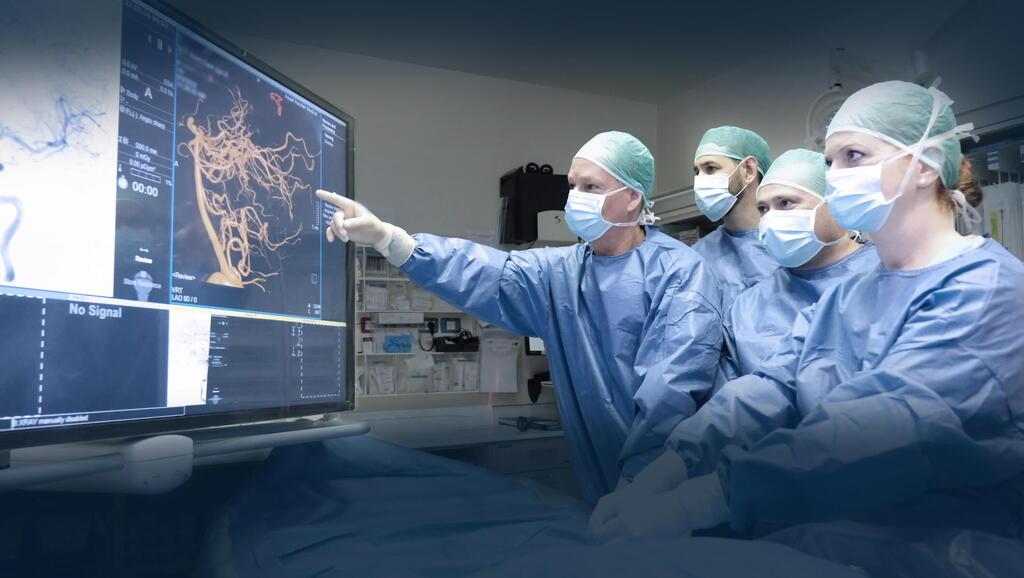Non-stop catheters
According to Israel’s Ministry of Health, the Shamir Medical Center (Assaf Harofeh) is the national leader in brain catheterizations of stroke patients. Meet the people who save lives non-stop
It is impossible to argue with the facts. According to the Ministry of Health, the number of catheterizations performed at the Shamir Medical Center (Assaf Harofeh) is double the national average. “The Unit performs complex and diverse operations, including for the treatment of brain aneurysms, blood vessel impairments, brain tumors; stent implantation procedures in carotid arteries; and of course, invasive treatment for stroke patients," says Dr. Levite, Director of the Marla Dan Interventional Radiology Institute at Shamir Medical Center. “In 2021, we performed over 170 catheterizations on stroke patients, while the national average for Israeli hospitals is 80-90 similar procedures per year. We are thankful to be able to help so many patients.”


The Marla Dan Interventional Radiology Institute at Shamir Medical Center (Assaf Harofeh) was established in 2015 by Dr. Ronen Levite and currently includes two senior catheterization specialists – Dr. Levite himself and Dr. Shani Avnery-Kalmanovitz. They work with dedicated nursing and X-ray teams that have undergone extensive training. The unit’s job is to save lives, every day, at any given moment. “50 to 70 percent of our on-call shifts are active shifts,” says Dr. Avnery-Kalmanovitz, “which means that catheterizations are performed almost every weekend and holiday. We receive patients from all parts of the country and today, according to the Ministry of Health, our unit is Israel’s leaders in the field.”
The brain doesn’t forget or forgive – stroke treatment must be immediate
Stroke is a deadly disease, which is the third most common cause of mortality in the Western world and the most common cause of morbidity in Israel and around the world. A small percentage of stroke patients will reach the catheterization bench. Most patients who require the procedure will die without an immediate and successful catheterization, or will suffer from a severe disability. “The brain neither forgets nor forgives,” says Dr. Avnery-Kalmanovitz. “The window of opportunity for treating stroke is narrow and the response must be immediate.”
“We are the professionals performing the catheterization, but the treatment of stroke is an integrated systemic effort,” says Dr. Levite. “This is a multidisciplinary task, which begins with identifying the patient’s problem (by the medical first responders) and correctly directing him or her to the medical center that can provide a comprehensive e response. At Shamir Medical Center, a rapid professional evaluation is conducted at the ER, including a full neurological assessment, imaging procedures among the world’s most advanced, and an urgent transfer to the catheterization unit in cases when catheterization is needed. The multidisciplinary involvement of the ER, the imaging units, and the anesthetic, intensive care, and neurological departments, with the proficiencies accumulated over the years, is the factor that ensures an effective and safe treatment in circumstances where every minute is critical."


Dr. Avnery-Kalmanovitz says, "Only this week, a 39-year-old mother of four young children came to us with a stroke caused by blockage of the central artery in the brain. Anyone who sees such a stroke cannot forget it – as a result of the stroke, the patient completely lost the ability to speak, could not understand and recognize those around her (including her own children), her face became contorted, and she could not move her right arm and leg at all. In less than an hour from entrance into the emergency room, she was in the catheterization room, and about half an hour later she had already gone through the catheterization and began to wake up. Several days later, she was released from the hospital fully functioning – returning to her husband, to her children, to life.”
Stroke affects not just older individuals
It is commonly thought that stroke is a disease of old age. In fact, about 25% of stroke victims are under 60, and about 10% are under 50. “The population’s growth, its maturation, and the expansion of indications for stroke catheterization are among the reasons for the increase in the number of patients suitable for catheterization over the years,” Dr. Levite says, “and in the range of ages. The youngest of the patients undergoing catheterization by our unit due to a stroke was 20 years old and today she is a mother. The oldest was a 102-year-old Holocaust survivor with a blockage in the main artery of the brain stem and he, to our delight, also recovered following the catheterization.”
“Mommy go, it’s important, you help people”
Dr. Levite is married to Vered and a father of two daughters; Dr. Avnery-Kalmanovitz is a mother of three. In Israel, there are only about 16 brain catheters that provide a solution for a population of over nine million people. Coping with the large number of cases and the multiplicity of calls takes a personal and family toll and requires the understanding and support of the spouse and children. “My husband runs the cardiac intensive care unit at Shamir Medical Center,” says Dr. Avnery-Kalmanovitz. “The nicest thing that the children tell us all the time is, ‘Mommy go, it’s important, you help people.’ To hear it from a five-year-old is exciting and makes me believe that maybe, despite this unconventional lifestyle, we managed to do something good.” Dr. Levita concludes by saying, “You can’t just get up in the morning and say, 'Today I'm not coming to work.' If we do not arrive, a patient may be hurt or die; there is no one else to catheterize. It’s as simple as that. The need for catheterization to be available non-stop is a personal and family effort that requires cooperation and sacrifice by the family. Only in this way can we realize the privilege afforded to us, to engage in the profession we love so much.”